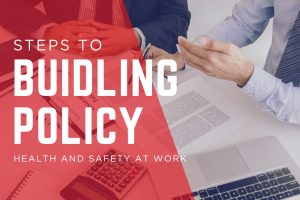It often begins with something small. A wet floor sign missing, a cluttered fire exit, a chair with a broken wheel. These things don’t always cause injury, but when they do, the consequences can be serious. For businesses, the ripple effects of a health and safety oversight can result in legal, financial and reputational damage. Despite the obvious risks, many small and medium-sized organisations still operate without a clear, structured health and safety policy. Not because they don’t care, but often because they don’t know where to start.
Why health and safety policies matter
It’s easy to see health and safety as the domain of large-scale industrial sites or high-risk construction zones. Whether you run a manufacturing plant in Wolverhampton, a tech startup in Birmingham, or a dental practice in Solihull, health and safety is part of your day-to-day reality. A good health and safety policy sets the tone. It shows that an organisation understands its duties, takes them seriously and is actively putting plans in place to reduce risk. It tells staff they’re valued. It tells regulators you’re compliant. And it tells clients, partners and the wider community that you’re a responsible, professional business. Without one? You’re flying blind. You’re relying on luck. And that’s not a strategy.
What is a health and safety policy?
At its core, the policy is a written document that outlines how an organisation manages health and safety in the workplace. It identifies who does what, when and how. It expresses your commitment to safeguarding your workforce and proactively managing risk. It explains how safety responsibilities are allocated and it describes the practical steps in place to prevent harm. It covers everything from first aid procedures and fire safety plans, to reporting accidents and conducting risk assessments. Think of it as a blueprint for your approach to protecting the people who make your business work.
Do all businesses need one?
If your business employs five or more people, then yes, by law, you must have a written health and safety policy. That’s the simple legal threshold set by the Health and Safety Executive (HSE) in the UK. But even if you have fewer than five employees, creating a policy is still strongly recommended. Why? Because a policy is a foundation for accountability.
A properly developed health and safety policy does more than keep you on the right side of the law. It can drive down incidents and improve efficiency. When everyone knows their responsibilities and how to carry them out, your operations run more smoothly and safely. There’s also a reputational benefit. Clients and partners want to work with organisations that take safety seriously. For businesses seeking contracts, especially with local authorities or larger organisations, a robust health and safety policy is often a prerequisite. And then, of course, there’s peace of mind. Knowing that your workplace is a safe place to be, and that your duty of care is being fulfilled, is something that can’t easily be measured but is certainly felt.
What does the law say?
The legal landscape around health and safety in the UK is governed primarily by the Health and Safety at Work Act 1974. Under this Act, employers have a duty to ensure, so far as is reasonably practicable, to protect the health, safety and welfare of their employees while at work. The Management of Health and Safety at Work Regulations 1999 further require employers to conduct risk assessments and put appropriate measures in place. And, as mentioned earlier, if you employ five or more people, you must have a written health and safety policy. Regulators like the HSE have the power to inspect, investigate and prosecute if standards aren’t met. And in the digital age, public scrutiny can be just as unforgiving as legal consequences.
What should the policy contain?
A strong policy typically has three main components: the statement of intent, the responsibilities section, and the arrangements for health and safety.
The statement of intent is where your organisation declares its commitment to health and safety. It’s often signed by the most senior person in the company and sets the tone from the top down. This is where you show leadership and establish that safety is a priority, rather an afterthought.
Next is the responsibilities section, which outlines who is responsible for what. This should be clear and specific. Who oversees first aid? Who conducts risk assessments? Who ensures new employees are trained? Delegation matters, especially when something goes wrong. Everyone needs to know their role.
Finally, the arrangements detail the practical steps you’re taking to keep people safe. This includes emergency procedures, equipment maintenance schedules, training programmes, reporting systems and risk management processes. It’s the ‘how’ of your policy, the day-to-day actions that bring it to life.
Embedding safety into your business
Creating a health and safety policy isn’t about bureaucracy, it’s about responsibility. While it may seem daunting at first, a health and safety policy doesn’t have to be complicated. Start with the basics: make a commitment, assign responsibilities and outline your approach. Review it regularly and update it as your business evolves. Because in the end, a safe workplace is a successful one.


